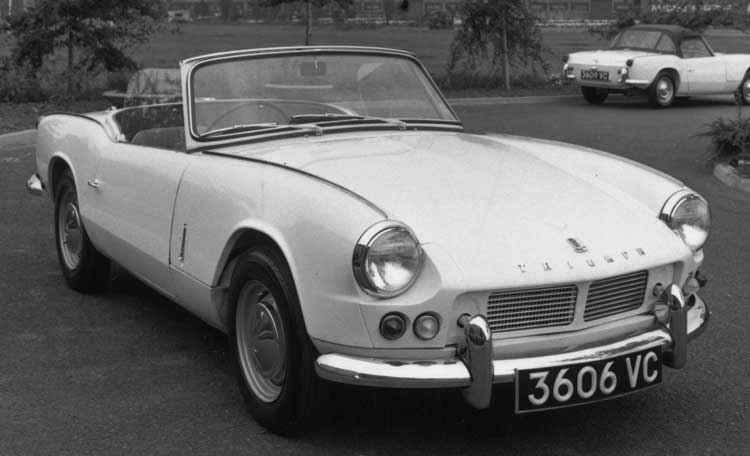Triumph Spitfire
With wind in your hair and the exhaust roaring, it's easy to love this car - despite the dodgy cornering.

Before embarking on a look back at the Triumph Spitfire, I thought I'd better consult a friend who's owned one. So I phoned Sarah Macaulay, who went to school with my wife and - like many busy parents these days - does lengthy driving stints in a big new SUV around Kent, delivering and collecting her three young sons.
In contrast to my mild disdain for these little cars (I once owned a Triumph Herald convertible, and a right bag o' nails it was too), it was as if I'd mentioned some handsome heart-throb from her teens.
"Oh!" she gasped. "It was my first car, and I loved it so much! It's such fun to drive and it has a lovely-sounding engine. The Spitfire was always something I imagined I'd have when I grew up. I lived and worked in Hong Kong until 1988 and, when I came back to the UK, I saw a Spitfire and was absolutely determined to get one. It's just so eye-catching."
Hmm. After this effusive tribute, it felt churlish to lampoon the Spitfire - as I'd intended to - as just another of those great British motoring lash-ups. It was based wholesale on the Herald, introduced in 1959, which featured an old-fashioned separate chassis and bolt-on body panels. It had this because Triumph was cash-strapped, and a modern combined body/chassis structure would have required a huge investment.
Yet the Herald had enormous appeal, thanks to a sleek and artfully detailed body style - the antithesis of the rounded, bulbous Morris Minor, a competitor. It was the work of Italian designer Giovanni Michelotti, a past master at styling Ferraris, so little wonder Triumph called Michelotti in again to design the 1962 Spitfire, its Herald-based rival to the Austin-Healey Sprite. A lovely job he did too, with the undulating, low-slung roadster lines whose immediate attraction endures to this day as essential to the archetypal sports car: long bonnet, snug cockpit, short tail.
The engine wasn't exactly fiery, a 63bhp twin-carburettor edition of the Herald's 1,147cc four-cylinder powerplant. But it was eager enough to outrun the Sprite - good for 90mph with 0-60mph in 16.5sec. Its front disc brakes brought the Spitfire to a rapid halt.
In terms of roadholding, however, the Spitfire inherited the Herald's serious flaw - swing axles incorporated into its independent rear suspension.
It also had one of the Herald's more dubious plus-points, a tight, 25ft turning circle made possible by the separate chassis frame. These helped to make Spitfires twitchy cars in corners taken too fast, when the suspension would jack them up at the back and unseat them.
A new owner might only have discovered this after spinning off the road in a fit of screaming-rubber oversteer. After all, pundits then were oblique. In its road test, Motor declared: "Handling is safe and enjoyable."
But you needed to absorb the whole paragraph. "As the cornering limit is approached, the tail 'hangs out' and a little steering has to be paid off, after which the chosen line will be followed closely," it said. "Long fast curves have to be approached with some caution until this change-over has been effected.
"The car has to be allowed to regain its balance from one corner before taking the next; it has to 'step off on the right foot', as it were."
It all depended, of course, on how you defined "safe" handling. There again, timid drivers, as much as macho ones, would be unlikely to get into trouble. And, with the wind in your hair and the throaty exhaust, the Spitfire was intoxicating even on a trip down to Fine Fare. A decent soft-top, roomy boot and 38mpg made it a practical proposition too, and cost £729.
More power wasn't really needed, but the 1965 Spitfire MkII gained 4bhp extra from its new 1,296cc engine, and there was 8bhp more for the 1967 MkIII. The Spitfire could now hit the ton, preferably on a dead-straight road....
In 1970, Triumph revamped the car completely, giving this MkIV new and rather more elegant bodywork, and a detuned engine to rein in both power and, for the US market where the Spitfire sold well, its exhaust emissions.
Best of all, Triumph engineers fettled the rear suspension; they now called it "swing-spring", and pretty much cured previously wayward tendencies. "The Spitfire's cornering behaviour is now completely safe and predictable," declared Motor, with a silent sigh of relief.
The final change came in 1975 when a 1,500cc engine meeting all American anti-smog rules was standardised. In this ultimate guise, the Spitfire 1500 remained on sale until August 1980. It outlasted the Herald by a decade; the Spitfire had, by today's standards, an amazing 18-year lifespan, 314,332 finding devoted owners.
Indeed, it's so popular still that owners of classic Spitfires make up a large part of the 12,000-strong Triumph Sports Six Club, Britain's fifth biggest one-make car fan club. So you won't be surprised to hear Sarah Macaulay still has her 1976 P-reg Spitfire 1500 tucked away in her garage behind the Volvo XC90.
"We went on our honeymoon in it," she says, mistily. "It was only when we had children that I didn't use it every day, and the only way I'd ever sell it is if I couldn't store it." That's the Spitfire - it gets you like that.
Join our commenting forum
Join thought-provoking conversations, follow other Independent readers and see their replies
Comments
Bookmark popover
Removed from bookmarks